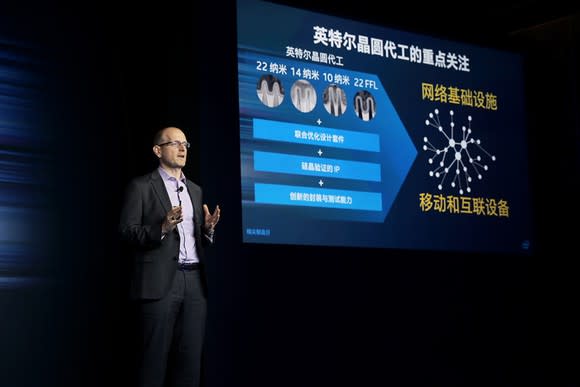Intel Makes Questionable Claim in Annual Filing
In chip giant Intel's (NASDAQ: INTC) most recent annual filing with the Securities and Exchange Commission, the company includes a section in which it goes over what it believes are its key competitive advantages over its peers in the industry.
Among the listed competitive advantages is the following:
We have a market lead in transitioning to the next-generation process technology and bringing products to market using such technology. In Q4 2017, we began to ship products utilizing our 10nm process technology and we are continuing to work on the development of our next-generation 7nm process technology. We believe these advancements will offer significant improvements in one or more of the following areas: performance, new features, energy efficiency, and cost.
Process technology refers to the manufacturing processes the company uses to manufacture its processors.

Image source: Intel.
The claim from Intel seems questionable at best. To illustrate, let's dive deep into when Intel has brought products to market on new technologies and when its competition -- Taiwan Semiconductor Manufacturing Company (NYSE: TSM) and Samsung (NASDAQOTH: SSNLF) -- have.
Organizing the data
In the table below, I have included the first product availability dates for several generations of process technologies from Intel, TSMC, and Samsung.
Company | 22nm/20nm | 14nm/16nm | 10nm | 7nm |
|---|---|---|---|---|
Intel | Q2 2012 | Q2 2014 | Q4 2018/Q1 2019 | ??? |
TSMC | Q3 2014 | Q3 2015 | Q2 2017 | Q3 2018* |
Samsung | Q3 2014 | Q1 2015 | Q1 2017 | Q1 2019* |
* Denotes projected availability based on company statements and credible reports. Table by author.
As we can see in the table above, it took Intel roughly two years to begin the transition from its 22-nanometer technology to its 14-nanometer technology, and it'll be more than four years before Intel is slated to announce its first products manufactured using its 10-nanometer technology.
Intel claims in its 10-K filing that it began shipping products based on its 10-nanometer technology in the fourth quarter of 2017, but those products have yet to be announced. By Intel's definition of "shipping," both TSMC and Samsung likely began shipping chips built using their respective 7-nanometer technologies sometime last year, as well.
What counts is when those products make it onto store shelves in devices the general public can buy.
TSMC and Samsung, on the other hand, have been moving noticeably quicker. It took TSMC about a year to go from its 20-nanometer technology to its 16-nanometer technology (admittedly 16-nanometer mainly brought performance and power efficiency improvements over 20-nanometer with a minimal area reduction), and it took it a year and three-quarters after the introduction of 16-nanometer to move to 10-nanometer.
The first products based on TSMC's 7-nanometer technology should debut in the third quarter of 2018 with the release of the next-generation iPhones -- a little more than a year after the first products based on its 10-nanometer technology made it to market.
We can see a similar trend with Samsung's release cadence (10-nanometer came out a little sooner for Samsung than it did for TSMC, but 7-nanometer will be a little later).
What about inconsistent naming?
Intel will argue, perhaps rightly, that its competition has taken some liberties with the naming schemes of its manufacturing technologies. The company claims that its own 14-nanometer technology is closer in terms of chip density to the foundries' 10-nanometer technologies, and that its 10-nanometer technology is closer in area density to the foundries' upcoming 7-nanometer technologies.
The reality, though, is that this doesn't matter -- what matters is the pace at which the companies are introducing new technologies, because that's what Intel specifically claims in the 10-K filing. The foundries have been moving faster, and their rapid pace of innovation has allowed them to match or, in some cases, exceed Intel in terms of chip manufacturing technology prowess.
More From The Motley Fool
Ashraf Eassa owns shares of Intel. The Motley Fool recommends Intel. The Motley Fool has a disclosure policy.

 Yahoo Finance
Yahoo Finance 